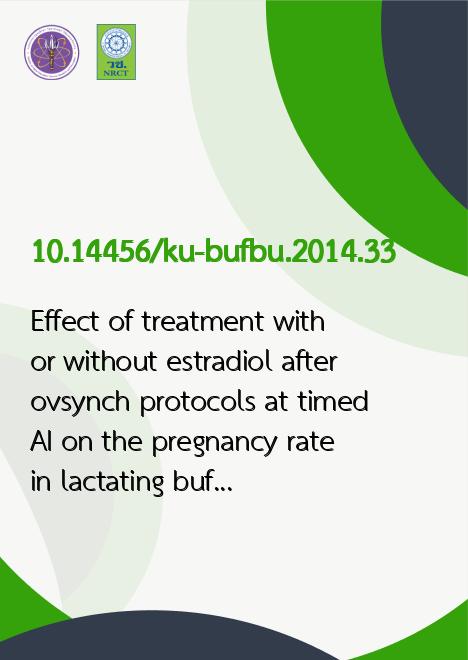
|
Effect of treatment with or without estradiol after ovsynch protocols at timed AI on the pregnancy rate in lactating buffaloes |
|---|---|
| รหัสดีโอไอ | |
| Creator | 1. Akhtar, M.S. 2. Ullah, S. 3. Lodhi, L.A. 4. Qureshi, Z.I. 5. Ahmad, I. |
| Title | Effect of treatment with or without estradiol after ovsynch protocols at timed AI on the pregnancy rate in lactating buffaloes |
| Publisher | International Buffalo Information Centre, Office of The University Library, Kasetsart University, Bangkok (Thailand) |
| Publication Year | 2557 |
| Journal Title | Buffalo Bulletin |
| Journal Vol. | 33 |
| Journal No. | 2 |
| Page no. | 184-191 |
| Keyword | Nili-Ravi buffaloes,Bubalus bubalis,Reproductive performance,Synchronization,Estrus,Ovulation,Pregnancy,GnRH,Estradiol,Ovsynch protocols,Pregnancy rate,Lactating,Artificial insemination,AI,Pakistan |
| ISSN | 1256726 |
| Abstract | The present study was conducted on forty lactating Nili-Ravi buffaloes to compare the reproductive performance by treating with GnRH and PGF2 alpha for synchronization of estrus, ovulation and pregnancy per artificial insemination with or without supplemental estradiol. All buffaloes received 25 mg PGF2 alpha at 51 days in milk (DIM) for pre-synchronization of estrus cycles. After 13 days of PGF2 alpha injection, buffaloes were given one of four treatments, Group A (n=10) were given an intramuscular injection of 100 micro g of GnRH followed by an injection of PGF2 alpha 7 days later and a final injection of GnRH at timed artificial insemination (AI) 48 h after the PGF2 alpha injection. Group B (n=10) were given the same treatment as that given to Group A buffaloes but with an injection of 1 mg of estradiol 24 h after the PGF2 alpha injection. Group C (n=10) were given an intramuscular injection of 100 micro g of GnRH followed by an injection of PGF2 alpha 7 days later and a final injection of GnRH at timed artificial insemination (AI) 72 h after the PGF2 alpha injection. Group D (n=10) were given the same treatment as that given to Group C buffaloes but with an injection of 1 mg of estradiol 24 h after the PGF2 alpha injection. Blood samples (10 ml) were collected from all buffaloes 7 days before and again at the first GnRH of the BuffSynch protocols, at 48 and 72 h after the PGF2 alpha injection of the BuffSynch and at 7 days after the final GnRH of synchronization protocols. Estrus was observed in 65 percent (13/20) of the buffaloes after the BuffSynch72 (Groups C and D) compared with 45 percent (09/20) buffaloes in the BuffSynch48 (Groups Aand B). Of the buffaloes which were treated with estradiol, 70 percent (14/20) displayed estrus as compared to 40 percent (08/20) of the buffaloes which were not treated with estradiol. Irrespective of treatments, a preponderance of buffaloes observed in estrus was identified 72 h after injection of PGF2 alpha. It is obvious that estrus expression increased after estradiol treatment however merely at 72 h or 48 h after estradiol injection. Among different treatment groups, pregnancy per AI at 40 and 68 days after artificial insemination did not differ. At 40 days after artificial insemination, pregnancy per AI rates were 45.0 percent for BuffSynch48 (Groups A and B) and BuffSynch72 (Groups C and D), whereas 45.0 percent for buffaloes with (Groups B and D) or without (Groups A and C) receiving estradiol treatment. It was concluded that lactating buffaloes exposed to presynchronized timed artificial insemination program with variable interval of proestrus before GnRH, in which artificial insemination was done at the time of final GnRH injection, practiced analogous pregnancy per artificial insemination. It is important that prolonging the period of proestrus and treating buffaloes with estradiol show estrus mainly at 72 h after PGF2 alpha but did not increase fertility. |